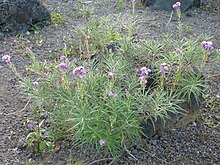Erysimum caboverdeanum
| Erysimum caboverdeanum | |
|---|---|

| |
| Erysimum caboverdeanum at the Botanical Garden in Las Palmas de Gran Canaria | |
| Scientific classification | |
| Kingdom: | Plantae |
| Clade: | Tracheophytes |
| Clade: | Angiosperms |
| Clade: | Eudicots |
| Clade: | Rosids |
| Order: | Brassicales |
| Family: | Brassicaceae |
| Genus: | Erysimum |
| Species: | E. caboverdeanum
|
| Binomial name | |
| Erysimum caboverdeanum | |
| Synonyms | |
|
Matthiola caboverdeana A.Chev, 1935 | |
Erysimum caboverdeanum is a species of flowering plants of the family Brassicaceae. The species is endemic to Cape Verde.[2] It is listed as a critically endangered plant by the IUCN.[1] The species was first described by Auguste Chevalier in 1935 as Matthiola caboverdeana;[3] it was placed into the genus Erysimum by Per Øgle Sunding in 1974. Its local name is cravo-brabo ("wild carnation").[4] It is used in traditional medicine.[5]
Description
The plant is a small shrub, reaching around 60 cm height. Its narrow leaves are up to 4 cm long and 0.2 cm wide. The flowers are lilac colored, the fruits are very narrow, up to 6 cm long and stand upright.[4]
Distribution and ecology
Erysimum caboverdeanum is restricted to the island of Fogo,[2] where it occurs between 1,600 and 2,000 metres elevation.[1]
References
- ^ a b c Catarino, S.; Duarte, M.C.; Romeiras, M.M. (2017). "Erysimum caboverdeanum". IUCN Red List of Threatened Species. 2017: e.T107426112A107468187. doi:10.2305/IUCN.UK.2017-3.RLTS.T107426112A107468187.en. Retrieved 20 November 2021.
- ^ a b Oromí, Martín, Zurita & Cabrera, 2005 : Lista preliminar de especies silvestres de Cabo Verde: Hongos, Plantas y Animales Terrestres. Gobierno de Canarias, Consejería de Medio Ambiente y Ordenación Territorial, p. 42
- ^ Chevalier, Auguste (1935). Les îles du Cap Vert : géographie, biogéographie, agriculture. Flore de l'archipel (PDF). Paris: Muséum national d'histoire naturelle, laboratoire d'agronomie coloniale: Tela Botanica. p. 260.
- ^ a b Plantas endémicas e arvores indígenas de Cabo Verde
- ^ Gomes, Alda Roque; Almeida, Guimarães de (October 2008). Plantas na medicina tradicional de Cabo Verde [Traditional Medicinal Plants of Cape Verde] (PDF) (in Portuguese). IICT /CCCM. p. 7. Archived from the original (PDF) on 2017-03-29. Retrieved 2016-11-03.
{{cite book}}:|work=ignored (help)

